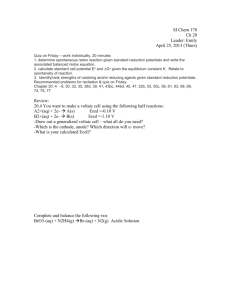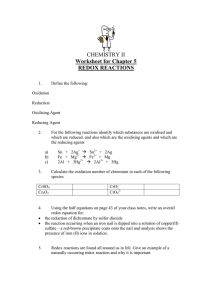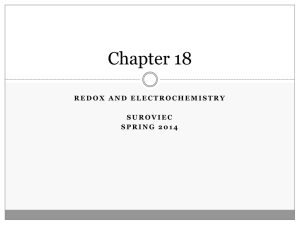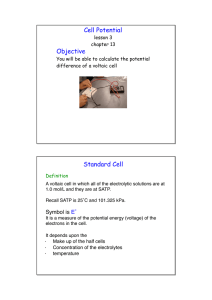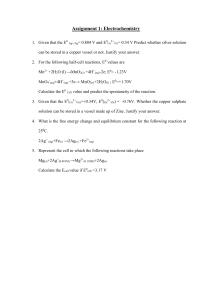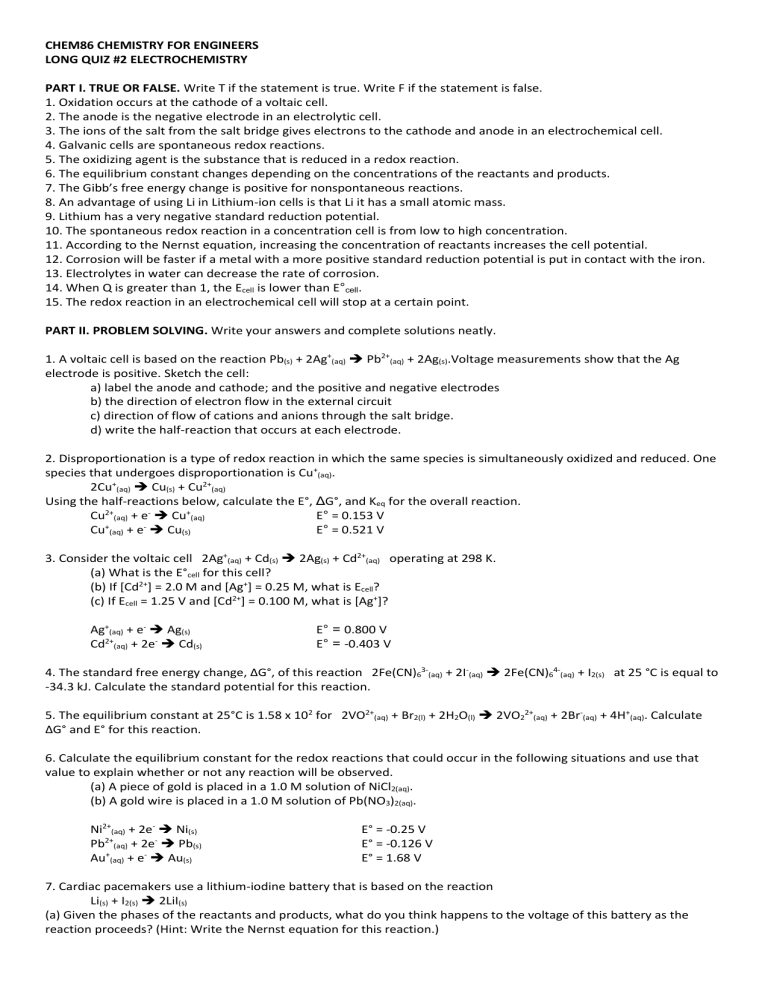
CHEM86 CHEMISTRY FOR ENGINEERS LONG QUIZ #2 ELECTROCHEMISTRY PART I. TRUE OR FALSE. Write T if the statement is true. Write F if the statement is false. 1. Oxidation occurs at the cathode of a voltaic cell. 2. The anode is the negative electrode in an electrolytic cell. 3. The ions of the salt from the salt bridge gives electrons to the cathode and anode in an electrochemical cell. 4. Galvanic cells are spontaneous redox reactions. 5. The oxidizing agent is the substance that is reduced in a redox reaction. 6. The equilibrium constant changes depending on the concentrations of the reactants and products. 7. The Gibb’s free energy change is positive for nonspontaneous reactions. 8. An advantage of using Li in Lithium-ion cells is that Li it has a small atomic mass. 9. Lithium has a very negative standard reduction potential. 10. The spontaneous redox reaction in a concentration cell is from low to high concentration. 11. According to the Nernst equation, increasing the concentration of reactants increases the cell potential. 12. Corrosion will be faster if a metal with a more positive standard reduction potential is put in contact with the iron. 13. Electrolytes in water can decrease the rate of corrosion. 14. When Q is greater than 1, the Ecell is lower than E°cell. 15. The redox reaction in an electrochemical cell will stop at a certain point. PART II. PROBLEM SOLVING. Write your answers and complete solutions neatly. 1. A voltaic cell is based on the reaction Pb(s) + 2Ag+(aq) Pb2+(aq) + 2Ag(s).Voltage measurements show that the Ag electrode is positive. Sketch the cell: a) label the anode and cathode; and the positive and negative electrodes b) the direction of electron flow in the external circuit c) direction of flow of cations and anions through the salt bridge. d) write the half-reaction that occurs at each electrode. 2. Disproportionation is a type of redox reaction in which the same species is simultaneously oxidized and reduced. One species that undergoes disproportionation is Cu+(aq). 2Cu+(aq) Cu(s) + Cu2+(aq) Using the half-reactions below, calculate the E°, ΔG°, and Keq for the overall reaction. Cu2+(aq) + e- Cu+(aq) E° = 0.153 V Cu+(aq) + e- Cu(s) E° = 0.521 V 3. Consider the voltaic cell 2Ag+(aq) + Cd(s) 2Ag(s) + Cd2+(aq) operating at 298 K. (a) What is the E°cell for this cell? (b) If [Cd2+] = 2.0 M and [Ag+] = 0.25 M, what is Ecell? (c) If Ecell = 1.25 V and [Cd2+] = 0.100 M, what is [Ag+]? Ag+(aq) + e- Ag(s) Cd2+(aq) + 2e- Cd(s) E° = 0.800 V E° = -0.403 V 4. The standard free energy change, ΔG°, of this reaction 2Fe(CN)63-(aq) + 2I-(aq) 2Fe(CN)64-(aq) + I2(s) at 25 °C is equal to -34.3 kJ. Calculate the standard potential for this reaction. 5. The equilibrium constant at 25°C is 1.58 x 102 for 2VO2+(aq) + Br2(l) + 2H2O(l) 2VO22+(aq) + 2Br-(aq) + 4H+(aq). Calculate ΔG° and E° for this reaction. 6. Calculate the equilibrium constant for the redox reactions that could occur in the following situations and use that value to explain whether or not any reaction will be observed. (a) A piece of gold is placed in a 1.0 M solution of NiCl2(aq). (b) A gold wire is placed in a 1.0 M solution of Pb(NO3)2(aq). Ni2+(aq) + 2e- Ni(s) Pb2+(aq) + 2e- Pb(s) Au+(aq) + e- Au(s) E° = -0.25 V E° = -0.126 V E° = 1.68 V 7. Cardiac pacemakers use a lithium-iodine battery that is based on the reaction Li(s) + I2(s) 2LiI(s) (a) Given the phases of the reactants and products, what do you think happens to the voltage of this battery as the reaction proceeds? (Hint: Write the Nernst equation for this reaction.) CHEM86 CHEMISTRY FOR ENGINEERS LONG QUIZ #2 ELECTROCHEMISTRY Name: ________________________________________________ PART I. TRUE OR FALSE 1 2 3 4 5 PART II. PROBLEM SOLVING 1 2 3 6 7 8 9 10 Date: __________________________________ 11 12 13 14 15 4 5 6 7
